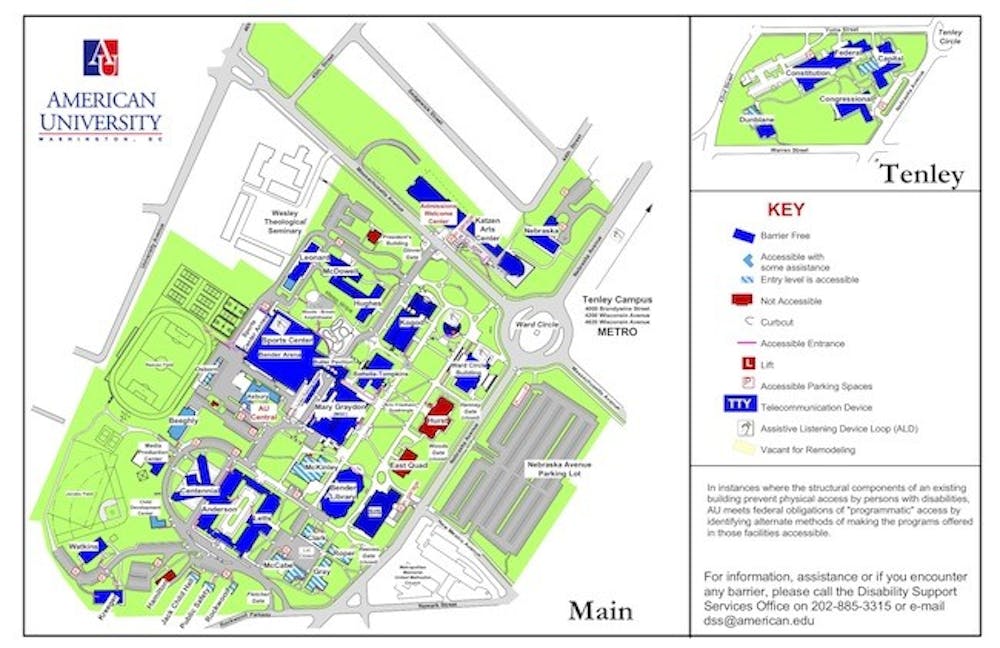The Disability Rights Coalition and the Student Government are working to make sure students with mental and physical disabilities are included in campus issues and are able to access all of AU’s campus facilities.
Although every student has a different experience, the biggest problem facing students with disabilities is equal access to and within classrooms, including entry to buildings or learning accommodations, according to Disability Rights Coalition President Allie Cannington, a sophomore in the School of Public Affairs.
East Quad Building, McKinley and Hurst are virtually inaccessible to students with physical disabilities.
Of the many challenges still facing students with disabilities, the biggest challenge is access to Hurst Hall, according to SG Director of Disability Support Terhas Clark, SG’s new point person to improve services and accessibility for AU students with disabilities.
Clark feels the school is essentially depriving students of their academic choices by not improving Hurst’s accessibility, as the entire Biology major is located in Hurst.
According to the Biology department, all biology professors’ offices are located in Hurst, as are most of their classes. Lecture classes may be moved to Ward if a student with a disability registers for the class. All lab classes are on the first floor Hurst, which is accessible from an outside lift, and cannot be moved.
Cannington said campus accessibility could be fixed by placing more of an emphasis on making sure buildings are in line with the guidelines set by the Americans with Disabilities Act.
“It’s not that hard to build a ramp,” said Ki’tay Davidson, a sophomore in SPA and the director of ableism awareness and community outreach for the Disability Rights Coalition.
Clark has collaborated with SG President Tim McBride and campus staff to improve the accessibility of the elevators in Jacobs Fitness Center. Before, students needed assistance to use the elevators, she said.
Clark is advocating for Resident Directors to sit down with students with disabilities at the beginning of each semester to discuss escape measures in the case of fires, she said.
For Clark, who is in a wheelchair, the problems caused by inaccessible campus facilities are ones she has experienced firsthand, both here and at Bard College in New York.
She had to transfer to AU because Bard’s campus was completely handicap-inaccessible.
“Coming to AU was like paradise,” she said.
Davidson also expressed the need to change the way disability rights are addressed. She said the stigma associated with disabilities is one of the greatest causes of problems for students.
“We’re trying to make people aware of the stigma and tell people that there are no differences,” Davidson said.
AU offices’ initiatives aim to support students with disabilities
AU’s Disability Support Services and the Academic Support Center have taken various measures to make the campus easier to navigate for students with disabilities.
Some of these measures include changing class locations for classes that are assigned to inaccessible buildings and providing interpreters and note-takers for students who need them, according to Disability Support Services.
The office staff is working on a number of new initiatives this year to improve the quality of their services, Disability Support Services Director Joanne Benica said in an email.
Some projects include conducting surveys to come up with new ways to support first-year students on the autism spectrum; collaborating with the Counseling Center to create a parent resource page; and working with AU Abroad to ensure that students with disabilities can fully participate in study abroad programs by making sure that proper accommodations are provided to students with disabilities.
Disability Rights Coalition advocates for equality
AU’s Disability Rights Coalition has been inactive for the past three years. Now, the coalition has 10 regular members and has just established its executive board.
Cannington said that, with the help of her vice president, Georgia Ottoni, she had to build a brand new organization.
“The goal of Disability Rights Coalition is based on celebrating disability as another part of human diversity,” Cannington said. “We want to create further inclusion and bring people with and without disabilities together.”
She emphasized that the organization looks at disabilities not as a medical issue, but as a human rights and equality issue.
“I think if it’s seen in that light, hopefully more people will be inclined to join the cause,” she said.





